Truk Lagoon (of the home counties)
Reprinted from ‘Diver’ magazine of July 1984, by kind permission of Divernet
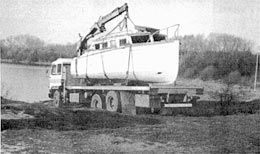
|
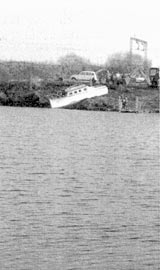
|
| Stages in the making of an interesting wreck dive. After arriving on a low loader (above) the ‘Bletchley Belle’ is nudged into the water by a JCB (right) and persuaded to the bottom in deeper water (left). |
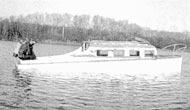
|
At Bletchley, 45 miles north of London, lies a disused clay pit known as the Blue Lagoon, which harbours the wrecks of three cabin cruisers and an aeroplane. How did this ‘Truk Lagoon’ happen? Was there some carrier-borne naval-air battle to repel the protagonists of a third London Airport, or did local citizens go down valiantly in the war against Luton Town Football Club moving to Milton Keynes? Nothing so romantic or dramatic occurred, as TOM TAYLOR reports.
Milton Keynes SAC novices don’t have to experience what can be the daunting transition straight from the training pool to the sea. They have the Blue Lagoon as their open-water training area, and this makes an excellent and safe way to graduate to sea diving. The Blue Lagoon is 250m by 300m and its maximum depth is 18m. This makes it ideal for snorkelling and diving drills. Unfortunately, many uninteresting dives took place when not even the local half dozen pike or the shy bream or tench were spotted, and a dive became more of a ‘getting wet exercise’ than a dive to remember.
A couple of years ago, the DO at that time, Tom Taylor, was involved in training a new group of Second Class divers and he saw an opportunity to make the Blue Lagoon more interesting, The Second Class trainees were asked to find and transport to the lagoon any suitable wreck, then to launch, float it out and sink it in a pre-determined position. It was, in fact, ship salvage and recovery in reverse.
The first to be committed to the depth was a Cessna 137 aeroplane, a write-off languishing at Luton airport. This arrived on a car trailer and quickly had builder’s planks and oil drums attached to make it float. It was then lifted into the water, and six divers, using fin-power, pushed it to its designated position.
Remember being glued to the television the weekend the Mary Rose was raised? MKSAC divers missed the TV coverage because they were very much involved in a reverse version of the lift. A 6m clinker-built cabin-cruiser laid up in a Norfolk farmyard was the next contribution. This is now known as the Rose Mary.
The next arrival was a 10m ship’s steel lifeboat which had had a cabin and deck added to convert it into a cabin-cruiser. This was recovered from a mud bank on the Thames at Maidenhead and brought to Bletchley on a large boat-trailer. A Land Rover backed the trailer onto a slope on the water’s edge, the lines cut and Milton Mabel took to the water like an RNLI lifeboat. For a moment it looked as if boat, trailer and Landrover were going to make a very expensive splash and become a ‘memorable dive’, but some fancy gear-changing saved the Landrover and trailer. British Leyland have been advised that their nought-to-sixty figures in Landrover adverts don’t do it justice. We’ve seen the time halved.
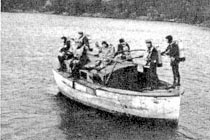
|
For Novice divers this is the ideal introduction to wreck diving |
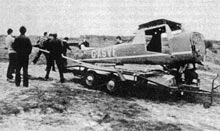
|
| ‘Milton Mabel’ en route to a watery grave. | The remains of the Cessna 137 are towed to the brink. It now houses marine life. |
The third wreck, renamed the Bletchley Belle was the most difficult to launch. We had it delivered on a low-loader which had its own lifting jib. Before delivery, we used a JCB to dig out a launching channel into the slope down to the water’s edge. When the 8m cabin-cruiser was lowered into this, the JCB nudged it into the water, It was then kedged into the required position and sunk.
Many shipwreck survivors will testify to the speed at which their boats disappeared underneath them, but try to sink one deliberately, and you become a victim of Murphy’s Law. The wooden boats, when holed, sank to their deck level, then refused to go under. We had to resort to concrete blocks, kerb stones and bricks to overcome their natural buoyancy.
Diving with a purpose
The divers involved with the projects achieved a sense of satisfaction in a successful ‘working dive’. This was above and below-water diving with a purpose. It entailed much planning and organisation, and the result is that the bottom of the Blue Lagoon now makes a more interesting dive. The wrecks are buoyed, but it is a good test of underwater navigation to do the grand tour of all the wrecks without surfacing to relocate them. The lagoon is visited by Branches from as far away as Birmingham to the North and Croydon to the South, and all have expressed their appreciation of the underwater improvements. For novice divers this is an ideal, safe introduction to wreck diving. The wrecks can be entered safely and they make a very good test of one’s tendency to claustrophobia. Having entered these, the Countess of Erne, James Egan Layne and Breda can be dived without apprehension.
Please, no robbery
Please, don’t be a wreck robber. The wrecks were placed there for the benefit of all divers and to lift a trophy from one of these is like taking pennies from a blind man, It would be nothing to be proud of. Diving at the Blue Lagoon is on a restricted numbers basis and the gate is kept locked, so, before embarking on your overland trek to the Home Counties Truk Lagoon please contact the Diving Officer at diving@mksac.co.uk to finalise arrangements. And if you know where there is a written-off Sea King helicopter…